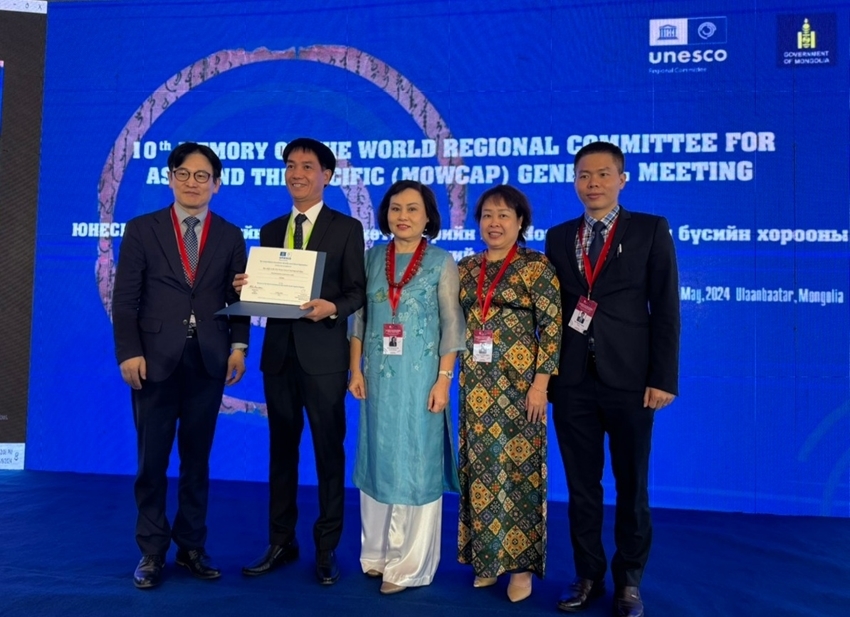
Thursday, 09/05/2024 18:22
(GMT+7)
The bronze castings on the Nine Dynastic Urns are registered as a World Documentary Heritage
TTH.VN - At 13:09 on May 8th (local time), in the capital city of Ulaanbaatar, Mongolia, Vietnam's dossier "Bronze castings on the Nine Dynastic Urns at the Imperial Citadel of Hue" was approved and officially became a documentary heritage of UNESCO's Memory of the World Programme for the Asia-Pacific Region.
 |
| "Bronze castings on the Nine Dynastic Urns at the Imperial Citadel of Hue" was approved and officially became a documentary heritage of UNESCO's Memory of the World Programme for the Asia-Pacific Region. Photo: TTBT |
Taking place from May 6th to 10th, the 10th General Assembly of the UNESCO Memory of the World Programme for the Asia-Pacific Region was held in Mongolia. During the meeting on May 8th, the conference focused on reviewing 20 valuable dossiers in various aspects and meeting criteria for significance in the region, uniqueness, and rarity. Vietnam had one dossier: The embossed bronze castings on the Nine Dynastic Urns at the Imperial Citadel of Hue" (Cửu Đỉnh), considered in this round.
 |
| The Nine Dynastic Urns – Hue Imperial Citadel is the 4th Documentary Heritage of Hue recognized by UNESCO. Photo: TTBT |
The Nine Dynastic Urns – Hue Imperial Citadel were ordered to be cast by Emperor Minh Mang in 1835 and completed in 1837, placed in front of The To Temple courtyard since its inception to the present day. Emperor Minh Mang ordered the casting of the Nine Dynastic Urns to signify the everlasting of the dynasty, the richness, and the territorial integrity of Vietnam. The exquisite bronze casting skills of Vietnamese artisans, with 162 carved patterns depicting various themes on the Nine Dynastic Urns, along with many deeply hidden values, have elevated the Nine Dynastic Urns beyond the stature of a national treasure. This is a unique and rare source of documentation that Vietnamese and foreign researchers are highly interested in due to its content value regarding history, culture, education, geography, feng shui, medicine, calligraphy, and especially the elevation of women's status under the feudal regime.
 |
| After nearly 200 years, amidst the vicissitudes of the era and the changes of time, the Nine Dynastic Urns remains intact. |
The bronze castings on the Nine Dynastic Urns have preserved the values of the intercultural exchanges and interactions of Vietnamese society with other countries in East Asia. Alongside the ups and downs of a dynasty, after nearly 200 years, despite enduring the upheavals of the times, the Nine Dynastic Urns remain intact. These rare treasures symbolize the sovereignty and existence of feudal dynasties in East Asian countries. With exemplary and unique values in form, content, and particularly in the intercultural exchanges and interactions of Vietnamese society with other countries in East Asia, at the 10th General Assembly, the UNESCO Memory of the World Committee for Asia-Pacific, the dossier "The Nine Dynastic Urns - Hue Imperial Citadel" was inscribed on the Memory of the World Register with 23 out of 23 participating countries voting in favor. The Nine Dynastic Urns – Hue Imperial Citadel are honored as the pride of Vietnam in general and of Thua Thien Hue province in particular, thereby enhancing the brand of Hue's heritage, one destination with eight UNESCO heritage sites.
Thus, as of the current time, The Nine Dynastic Urns – Hue Imperial Citadel is the 4th Documentary Heritage of Hue recognized by UNESCO after the Nguyen Dynasty Woodblocks (2009), the Imperial Archives of the Nguyen dynasty (2014), and the Poetry on Hue Royal Architecture (2016).
Story and photos: LIEN MINH